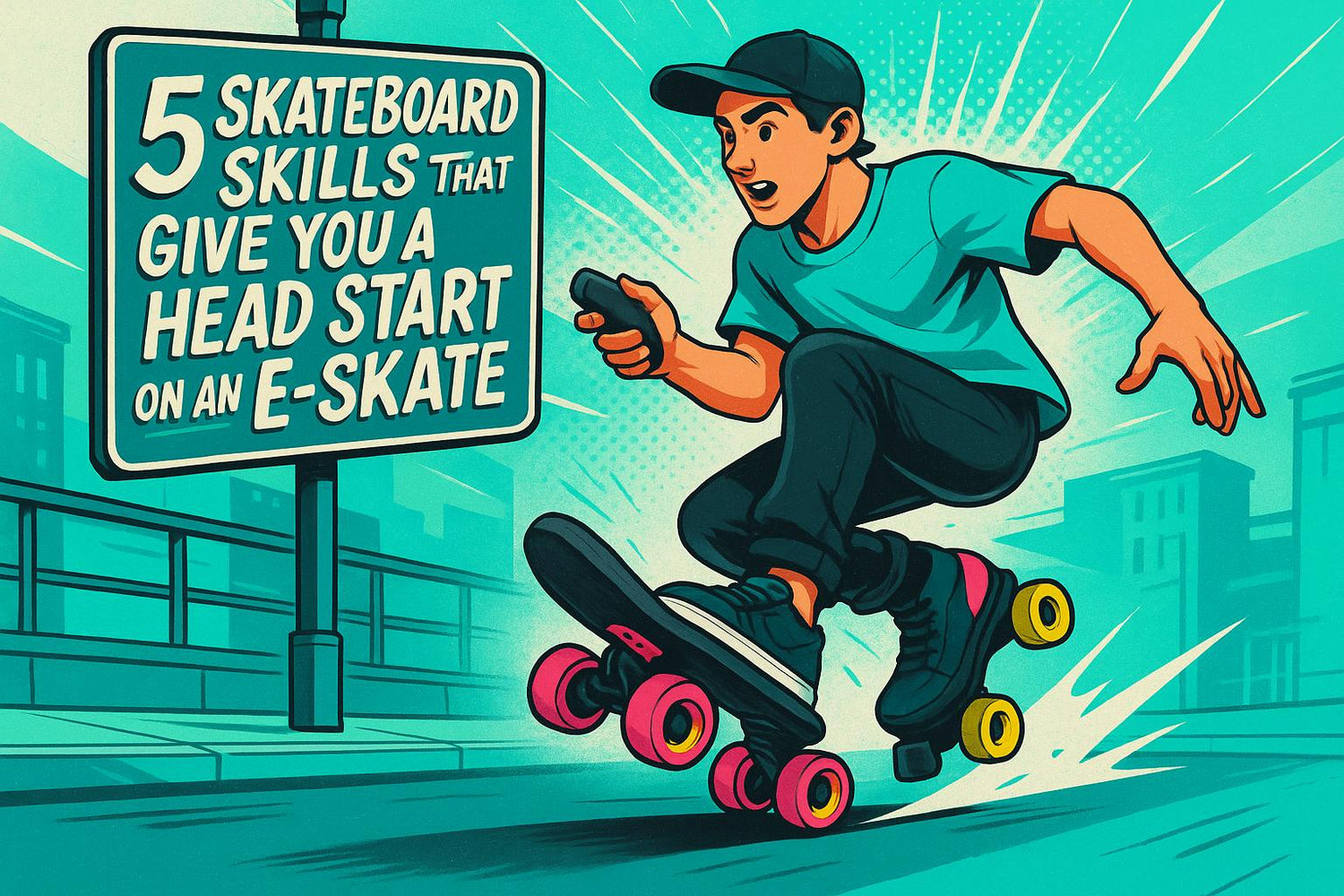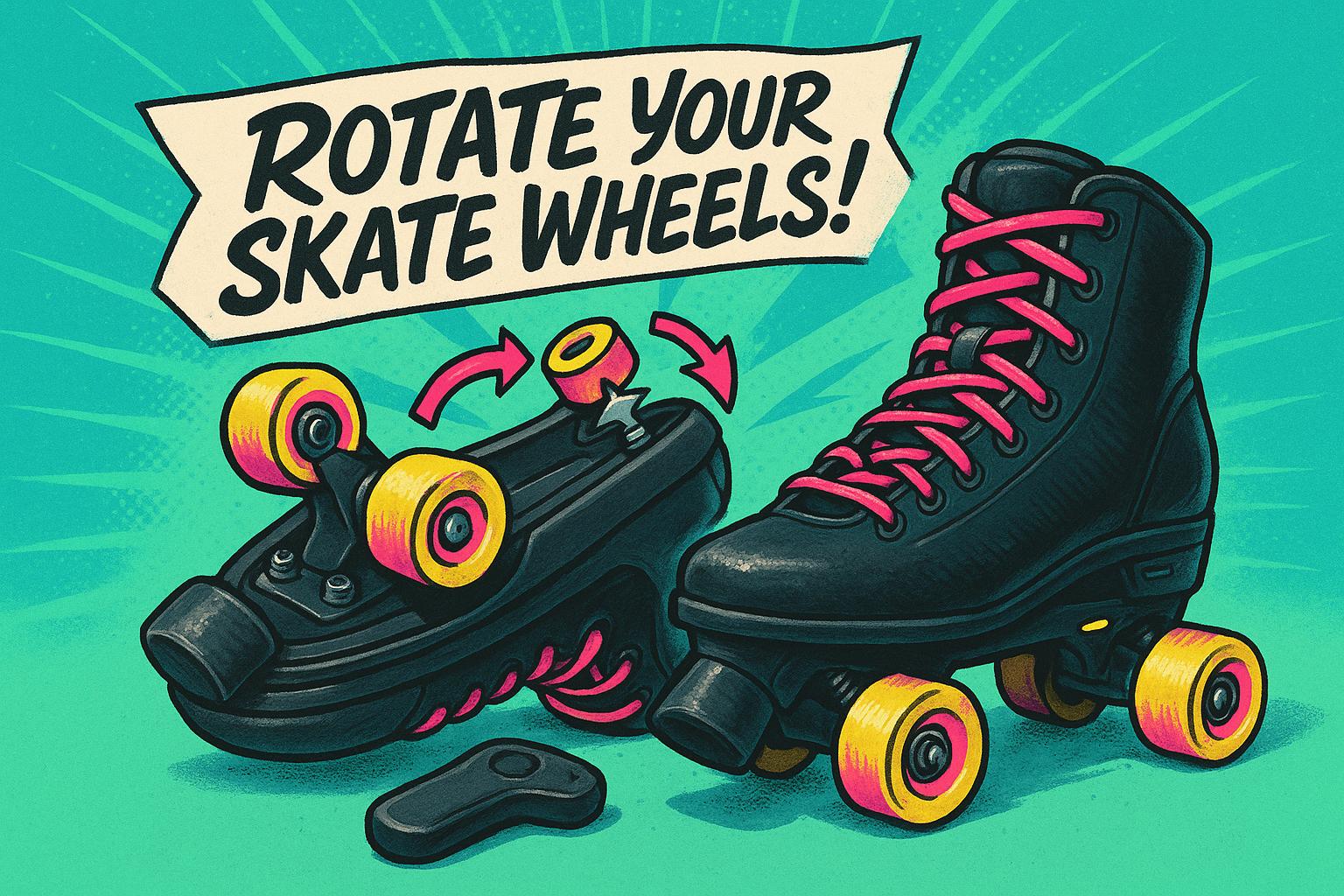If you’ve ever skateboarded, transitioning to electric roller skates is easier than you think. Skills like balancing, carving, and reading terrain directly apply. Electric skates like Wheelfeet offer speeds up to 15 mph with a 9-mile range, making them perfect for urban commutes. Instead of pushing off, you’ll control speed and braking with a remote. Here’s a breakdown of how your skateboarding experience gives you an edge:
- Balance: Skateboarding teaches body control, which helps you stay steady on powered skates.
- Carving: Smooth turns on a skateboard translate to controlled, motor-assisted carving.
- Foot Placement: Your stance skills carry over, crucial for stability and control.
- Stopping: Familiarity with stopping techniques helps you master regenerative braking.
- Spatial Awareness: Skateboarding sharpens your ability to navigate obstacles and busy streets.
Switching to electric skates requires learning motorized controls but builds on the skills you already have. With practice, you’ll handle city streets confidently and efficiently.
1. Balance and Stability
How Skateboarding Skills Carry Over
If you've spent time skateboarding, you're already familiar with the constant fine-tuning of your ankles, knees, and core to stay balanced. This gives you a head start when transitioning to electric skates. Unlike skateboards, which spread your weight more evenly, electric skates often have a lower center of gravity. This design naturally enhances your ability to balance while riding, making it easier to adapt to different scenarios.
Adapting to Electric Roller Skates
On electric skates, your movements are all about control and precision. Leaning forward triggers acceleration, while leaning back helps you slow down. Instead of pushing off the ground like on a skateboard, you rely on subtle ankle adjustments to stay steady while maintaining propulsion. Mastering these movements not only keeps you stable but also boosts your confidence across varying terrains.
Staying Safe and in Control
Skateboarding teaches you valuable lessons about safety - like bending your knees to lower your center of gravity and reduce fall risks. Plus, the ability to fall smartly - rolling with the momentum and protecting your wrists - translates directly to electric skating. These instincts and techniques can make a big difference when it comes to staying safe and in control.
Navigating City Streets with Confidence
In urban environments, the balance and body awareness you've developed from skateboarding are indispensable. City riding often means dealing with uneven sidewalks, curbs, and weaving through pedestrian traffic. Whether you're slowing down for a crosswalk or dodging obstacles, the stability you've honed makes commuting less stressful and much smoother.
2. Carving and Turning Technique
Skill Transfer from Skateboarding
If you've spent time on a skateboard, you already have a solid foundation for carving. The balance and smooth turns you've developed on a traditional board give you a head start when transitioning to electric skates. However, the experience isn’t identical. Electric skates are heavier and powered, so while the principles of weight distribution and edge control remain the same, you’ll need to adjust your approach to suit the added weight and motor responsiveness.
"Electric skateboards are generally heavier, so turning might feel different. Use your experience with carving on a traditional skateboard but apply it more gradually to accommodate the added weight and motor responsiveness." - Shamim Ahamedo, Author, Meepo Board News
Applying Carving to Electric Roller Skates
When carving on electric skates, it’s crucial to start slow and focus on control. The motor’s response and the board’s weight require deliberate, measured movements. Pay attention to how you shift your weight - lean forward slightly when accelerating through a turn and shift back when slowing down or braking mid-carve. This balance ensures smoother and more stable turns, especially when navigating challenging terrain.
Enhancing Safety and Control
Perfecting your carving technique isn’t just about style - it’s a safety tool. Proper weight distribution can prevent speed wobbles, a common issue when riding at higher speeds. Applying more pressure to your front foot helps maintain stability. By practicing controlled carving, you reduce the risk of falls, particularly during sharp turns or sudden maneuvers.
Navigating Urban Environments
In busy urban areas, carving is more than a skill - it’s a necessity. Tight spaces, pedestrians, and unexpected obstacles demand quick and controlled directional changes. Mastering gradual, deliberate carving allows you to maintain momentum while weaving around obstacles. This predictability in movement not only boosts your confidence but also makes commuting through crowded streets much safer and more efficient.
3. Foot Placement and Stance
Skill Transferability from Skateboarding
If you’ve spent time perfecting your balance and carving skills on a skateboard, you’re already ahead of the game when it comes to electric skates. Your skateboarding stance - whether it’s regular (left foot forward) or goofy (right foot forward) - translates naturally to motorized riding. That familiarity gives you an edge as you navigate the nuances of electric skates.
The shoulder-width stance you’ve mastered on a skateboard is just as important here, helping you counterbalance the motor’s weight distribution. With knees slightly bent and your weight centered, your body is already trained to maintain a stable, athletic position. This solid foundation makes it easier to adapt to the more refined foot positioning electric skates require.
Practical Application to Electric Skates
Electric skates bring their own set of challenges, especially with motor and battery placement affecting weight distribution. To counter the typically rear-heavy design, applying a bit more pressure with your front foot can help maintain stability. The heel-to-toe alignment you’ve practiced on a skateboard also proves essential here, giving you better control over the board’s movements. Keeping your feet parallel to the edges of the deck enhances your ability to feel the motor’s response, allowing for smoother acceleration and braking.
Impact on Safety and Control
A proper stance isn’t just about comfort - it’s key to staying safe, especially in emergency situations. Your skateboarding experience has already taught you to keep a low center of gravity and a stable, slightly wider stance. These habits are invaluable for minimizing issues like speed wobbles, which can be a common hurdle for new riders.
Quick adjustments to your stance can make all the difference when riding electric skates. Whether you need to shift your weight to dodge a pothole or swerve around a pedestrian, the muscle memory you’ve built from skateboarding allows you to react swiftly and effectively. This ability to reposition on the fly significantly lowers the risk of falls, especially during the learning stage.
Relevance to Urban Commuting
Urban environments demand consistent and precise foot placement, and your skateboarding background equips you with the stability needed for long commutes. Unlike skateboarding, where you might frequently adjust your stance for tricks or terrain changes, electric skating often requires holding a steady position for extended periods. This consistency not only reduces fatigue during longer rides but also helps you stay in control.
City streets come with their own set of challenges - uneven pavement, scattered debris, and the need for sudden stops. Keeping your feet securely positioned while staying alert to traffic, pedestrians, and other obstacles becomes second nature, building on the stance control you’ve already honed through skateboarding.
4. Stopping Methods
How Skateboarding Skills Translate to E-Skates
If you've spent time skateboarding, you're already familiar with controlling speed and shifting your weight to decelerate. These skills are incredibly helpful when learning to stop on electric skates. While e-skates rely on electronic braking systems, the balance and timing you've developed on a skateboard can make a big difference in mastering safe stops.
E-skates take these instincts to the next level, incorporating advanced systems to ensure smoother and safer braking.
Braking Systems in Electric Skates
Electric skates typically come with remote controls or smartphone apps that allow you to manage speed and braking. Many models also feature regenerative braking systems, which convert your momentum into battery power. This technology not only helps with energy efficiency but also provides a smoother stopping experience - something you'll appreciate when navigating busy city streets.
Why Reliable Braking Matters in Urban Areas
In urban environments, dependable braking is more than just a convenience - it's essential for safety. Skateboarding teaches you how to position your body and gauge stopping distances, skills that blend seamlessly with the electronic systems in e-skates. Together, these elements allow for better speed control and quicker reactions, helping you handle the unpredictable nature of city commuting.
sbb-itb-bf837b9
5. Spatial Awareness and City Navigation
How Skateboarding Prepares You for E-Skating
Skateboarding trains you to constantly scan your surroundings - watching for obstacles, pedestrians, and sudden changes in terrain. Over time, this heightened awareness becomes second nature, and it's exactly the kind of skill you need when navigating urban streets on electric skates.
The mental mapping you develop while skateboarding - like gauging when to slow down before a sharp turn, calculating how much space you need to maneuver, or estimating distances - translates directly to electric skating. Your brain is already wired to process visual information quickly and make on-the-spot decisions, which is crucial when you're riding in fast-paced city environments.
Using These Skills on Electric Skates
Electric skates demand the same kind of spatial judgment and environmental awareness you've honed on a skateboard. This includes planning your route, anticipating obstacles, and reading the flow of traffic.
For instance, your skateboarding background helps you interpret subtle cues in your surroundings, like recognizing when a pedestrian might step into your path or spotting a car door about to swing open. These instincts are especially useful when you're gliding through city streets at higher speeds, where quick reactions are key.
Staying Safe and in Control
The spatial awareness you’ve developed through skateboarding also plays a big role in staying safe on electric skates. It helps you maintain control, even when managing speed and braking with wireless controls.
Your experience with surface textures and terrain changes gives you a clear advantage. Whether it's spotting a wet patch, loose debris, or uneven pavement, you’re better equipped to avoid hazards that could affect your traction or stability. This kind of predictive awareness is critical when riding in busy urban areas.
Making Urban Commuting Easier
City commuting on electric skates demands quick thinking and smooth coordination, both of which are second nature to seasoned skateboarders. Your ability to anticipate and adapt helps you safely navigate through a mix of bikes, pedestrians, and vehicles.
And let’s not forget the eco-friendly appeal of electric skates - they’re perfect for regular commuting. Thanks to your spatial awareness and planning skills, you can seamlessly integrate into traffic patterns, positioning yourself in ways that keep both you and others safe while sharing the road.
The electric skateboard that moves like a snowboard (Summerboard review)

Skill Comparison Table
Below is a breakdown comparing essential skateboarding skills with their electric skating counterparts. This table highlights the key adjustments needed when transitioning between the two.
| Skill | Skateboarding | Electric Skating | Key Differences |
|---|---|---|---|
| Balance & Stability | Maintaining balance on a moving board by adjusting your body to momentum changes | Dynamic balance supported by motorized assistance, adapting to speeds up to 15 mph | Electric skates provide motorized stability but require learning to handle powered acceleration and deceleration |
| Carving & Turning | Using weight shifts and ankle pressure to steer; turns depend on momentum | Similar weight shifts combined with speed control via a wireless remote; turns are powered by the motor | Electric skates eliminate the need for physical pumping, but you’ll need to focus more on speed control during turns |
| Foot Placement | Front foot angled, back foot perpendicular for pushing and steering | Both feet secured in skate boots, with balanced weight distribution for better control | Electric skates remove the push-off technique but retain steering principles with secured foot placement |
| Stopping Methods | Techniques like foot braking, heel dragging, controlled slides, or jumping off | Regenerative braking managed through a wireless remote | Electric braking offers smoother stops while recharging the battery, requiring coordination with the remote |
| Speed Control | Achieved through pumping, pushing, gravity, and natural momentum loss | Controlled via a wireless remote with adjustable settings and regenerative braking | Electric skates maintain consistent speeds with minimal effort, but efficient use of battery and remote control is key |
| Terrain Adaptation | Reading surface textures, adjusting stance for obstacles, and manual navigation | Combines reading surfaces with motorized power adjustments for different terrains | Motor assistance makes handling inclines and rough surfaces easier, reducing physical strain |
Switching from traditional skateboarding to electric skates involves adapting your skills to new tools and dynamics. While your muscle memory and spatial awareness will ease the transition, the main challenge lies in mastering the wireless remote and integrating it with your movements.
Safety is another area where the two differ significantly. Skateboarding often relies on quick bail-outs or jump-offs in tricky situations, but electric skates keep your feet securely in place. Instead, regenerative braking and precise speed control become your go-to safety measures. With Wheelfeet’s adjustable speed settings, you can start slow and build confidence as you get used to powered movement.
The 9-mile range and lightweight design of these electric skates also redefine longer rides. Instead of exhausting yourself with constant pushing, you can maintain a steady pace over extended distances. Your experience in reading terrain and planning routes will still come in handy, but now you’ll have the added benefit of motorized assistance for a smoother, less tiring ride.
Conclusion
If you're already skilled at skateboarding, you're in a great position to transition to electric skates. The core skills you've honed - like balance, carving, foot placement, stopping, and spatial awareness - naturally carry over to powered skating. Your ability to manage momentum on a traditional board directly applies to handling electric acceleration and working with motorized assistance.
That said, there’s an adjustment period. Instead of pushing off with your back foot, you’ll learn to control speed using a wireless remote. And rather than relying on foot braking or quick bail-outs, you’ll embrace regenerative braking, which not only slows you down smoothly but also recharges your battery.
Wheelfeet makes this transition easier with features like adjustable speed settings, allowing you to start slow and build confidence. The lightweight design ensures you stay agile, while the regenerative braking system provides precise control that feels intuitive once you’ve adapted. Together, these features create a seamless experience for urban mobility.
Whether you're commuting or just cruising around, your skateboarding background already gives you an edge. You know how to read road surfaces, steer around obstacles, and maintain balance through sharp turns. Adding electric power to the mix simply amplifies these abilities, letting you navigate city streets with ease. By blending your skateboarding expertise with modern tech, you’re ready for a ride that’s not just faster and cleaner but also more enjoyable.
FAQs
How does learning balance and stability on a skateboard help me ride electric skates more safely?
Mastering balance and stability on a traditional skateboard lays the groundwork for better safety and control when transitioning to electric skates. By working on your core strength, fine-tuning weight shifts, and improving your posture, you'll be better prepared to tackle challenges like speed wobbles, sharp turns, and unexpected movements with ease.
These fundamental skills not only build confidence but also significantly lower the chances of falls and accidents. The more at ease you are balancing on a regular skateboard, the more seamless and intuitive riding electric skates will become.
How does carving on an electric skateboard differ from a traditional skateboard, and how can I adapt my technique?
Carving on a traditional skateboard is all about quick weight shifts and sharp foot movements to navigate tight turns, emphasizing agility and precision. In contrast, an electric skateboard offers a different experience. The heavier deck and motorized setup result in smoother, less reactive carving.
To adjust, aim for wider, more gradual turns by shifting your body weight and using the board's tilt controls rather than relying on aggressive leaning. Spend time practicing balance at higher speeds to make the most of the motor's stability while staying in control. With these tweaks, you'll carve smoothly and confidently on your electric skateboard.
How can my skateboarding skills in spatial awareness and obstacle navigation help me ride electric skates in busy city areas?
If you're a skateboarder, your knack for spatial awareness and navigating obstacles gives you a clear advantage when it comes to riding electric skates in busy urban areas. These skills allow you to quickly read your surroundings, dodge pedestrians or potholes, and make smart, split-second decisions to stay safe.
Since you're already used to balancing and maneuvering in ever-changing environments, transitioning to electric skates for city commuting feels much more natural. This not only makes your rides smoother and safer but also a lot more enjoyable, even in the chaos of crowded streets or unpredictable conditions.




Leave a comment
All comments are moderated before being published.
This site is protected by hCaptcha and the hCaptcha Privacy Policy and Terms of Service apply.